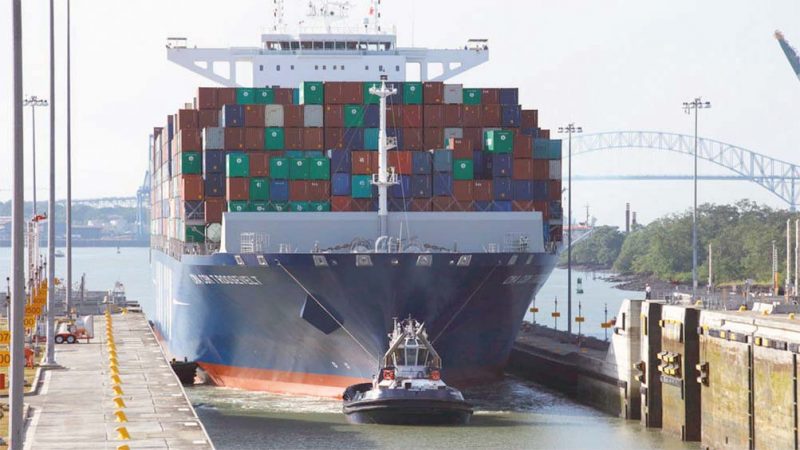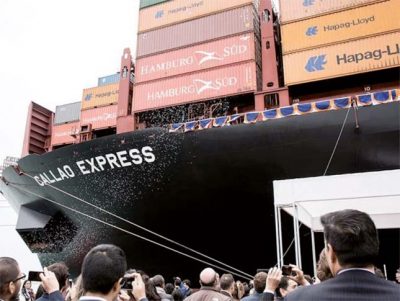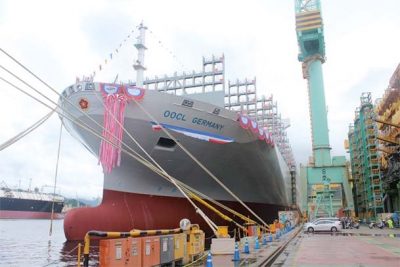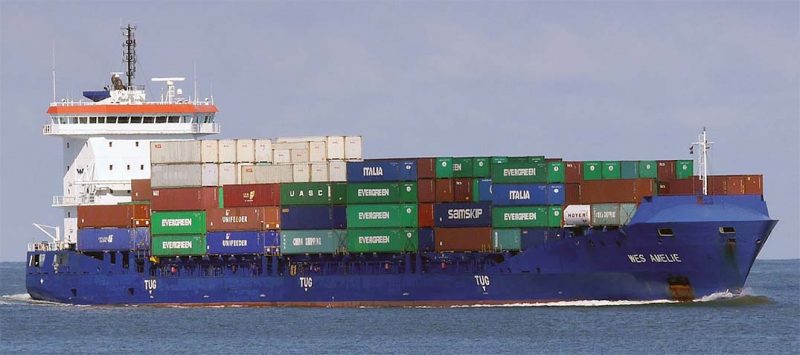APL, a subsidiary of CMA CGM, has added a new weekly Asia Latin America Express 3 (AE3-AW3) service that now connects China, Hong Kong, Taiwan and other key Asian markets to Mexico and the West Coast South America. Designed with the industry’s fastest transit time from Ningbo to Mexico, Panama and Colombia in just 18, 24 and 27 days respectively, the AE3-AW3 service also facilitates market access to the South Chilean market with its port of call at San Vicente. Likewise, westbound shipments on the service from Mexico, Colombia and Panama to Qingdao will take a mere 17, 24 and 26 days respectively. The first sailing of the eastbound service departed Kaohsiung on 23rd August while the westbound leg from Balboa commenced on 22nd September.
CMA CGM’s 140,872gt/2017 built and 14,885 TEU capacity Neopanamax vessel CMA CGM Theodore Roosevelt became the largest ever containership to transit the Panama Canal on 22nd August (above). The CMA CGM ship is deployed on the Ocean Alliance’s new weekly Asia-U.S. East Coast South Atlantic Express (SAX) service that commenced in early April with 11 vessels. The full port rotation of the service is Hong Kong-Yantian-Ningbo Shanghai-Colon (Panama)-Norfolk-Savannah-Charleston and back to Hong Kong. According to local new reports in China, CMA CGM also looks set to build nine of the world’s largest container ships (22,000 TEU) at two Chinese shipyards, namely Shanghai Waigaoqiao Shipbuilding Co. and sister yard Hudong Zhonghua Shipbuilding (Group) Co. Both yards are owned by state-run China State Shipbuilding Corporation.
Diana Containerships Inc. entered into a time charter contract with CMA CGM on 15th September for one of its Panamax container vessels, the 40,085gt/2001 built Domingo, for a period of 8-11 months. The 3,739 TEU capacity ship was previously chartered to Nile Dutch Africa Line B.V. Diana Containerships Inc.’s fleet currently consists of 11 container vessels (6 Post-Panamax and 5 Panamax). The company also reactivated the idle 54,809gt/2005 built and 5,042 TEU capacity Pamina for a charter with OOCL that began on 13th September 2017.
Hapag-Lloyd christened another of the five new 10,500 TEU capacity and 333m long/48m beam vessels on 25th August. The 118,945gt/2016 built ship was named Callao Express in a festive ceremony in the Peruvian port of Callao (above) and later departed for Puerto Angamos and Valparaiso prior to returning to Europe after sailing the South American west coast. Earlier in 2017 the Guayaquil Express was christened in Hamburg and the last ship of the five Valparaiso Express class, the Santos Express, will be named in Santos, the largest port of Latin America, on 21st November. The company further enhanced its Northern Europe short sea network by introducing a dedicated service connecting Antwerp and Rotterdam with the Baltic as from 6th September. The port rotation is as follows: Antwerp-Rotterdam-Gdynia-St. Petersburg-Helsinki-Gdynia-Antwerp and the first sailing was undertaken by the 33,662gt/1996 built Milan Express. This new service was necessary following the merging of the Hapag-Uoyd and UASC businesses and it employs two of Hapag-Lloyd’s highest ice class vessels which have a capacity of 2,500 TEU. Hapag Lloyd has also revealed that it has no plans to follow CMA CGM and MSC in building new 22,000 TEU capacity containerships after reporting strong second quarter earnings. The container shipping line, which is the fifth largest operator by vessel market share, expects the addition of its new fleet from the United Arab Shipping Company (UASC) merger to result in lower levels of investment in the future.
Maersk Line’s brand new Munich Maersk became the largest capacity ship of her type to call at Hamburg when she arrived on 5th August during her maiden voyage, and likewise at Malta Freeport in August. The 20,568 TEU capacity second generation Triple E class ship was delivered in June. The 94,193gt/2008 built Maersk Taurus is the most recent vessel to arrive at Hamad Port from the Port of Salalah, Oman. The vessel arrived mid-August with a total of 3,798 TEUs including 407 reefer containers. Such calls are part of efforts to ensure continuous flow of supplies in light of the recent measures taken against Qatar by its neighbours. The 214,286gt/2017built Moscow Maersk made her debut at Felixstowe on 28th August whilst on her maiden voyage. She is the third of 11 second generation Triple-E ships. The Moscow Maersk’s first trip had, rather fittingly, commenced in Russia. Maersk Line has acquired the final Hanjin containership to be sold, the 45,169gt/2013 built and 5,067 TEU capacity Hanjin Searle renamed Maersk Iyo.
MOL’s 210,678gt/2017 built MOL Tribute made her maiden call at Southampton’s DP World Container Terminal on 27th August 2017 (see page 60). Sistership MOL Trust visited on 21st July and the first of these 400m long and 20,150 TEU capacity ships, the MOL Triumph, called on 11th May 2017.
Mediterranean Shipping Company (MSC) and the Port of Duqm announced the arrival of the first MSC containers at the growing transportation hub. The containers were carried by the MSC Laurence from Antwerp to Jebel Ali, collected from there by an Oman Container Line feeder service, and discharged at the Port of Duqm on 5th August. MSC already operates services calling at the Omani ports of Salalah and Sohar so operations to the Port of Duqm will compliment these.
MSC has set a new record for the number of containers loaded and unloaded at any Australian port. The record exchange of 4,000 containers took place at Patrick Terminal in Port Botany, on the 83,133gt/2004 built MSC Ningbo, a 7,849 TEU capacity vessel cur rently operating on MSC’s Australia Express service, which directly links Australia with Europe on a weekly basis.

Matson, Inc. a U.S. carrier in the Pacific region, has announced that it will introduce a new extension of its South Pacific Express (SPX) service to Tahiti, providing twice monthly arrivals from the U.S. mainland and Honolulu to French Polynesia. Matson began accepting Tahiti shipments with the SPX departure of Samoana Voyage 007 from Honolulu on 22nd August and the first arrival at Papeete on 4th September 2017.
MPC Container Ships AS has taken delivery of a 2,127-TEU capacity vessel from a German owner. Technical management of the 22,801gt/2007 built AS Angelina is undertaken by Ahrenkiel Steamship whilst the commercial management of the vessel is being handled by Contchart. The company then took ownership of six containerships ranging in capacity from 1,300 TEU to 2,700 TEU in September, at which point its fleet totalled 20 vessels.
OOCL celebrated the christening of Hull H2173, the 210,820gt/ 2017 built and 21,413 TEU capacity newbuilding OOCL Germany on 22nd August (above). Constructed by Samsung Heavy Industries in South Korea, this containership is the second of six 21,000 TEU class vessels on order at the shipyard. The OOCL Germany will be serving the Asia-Europe trade lane on the LL1 service. The OOCLJapan (Hull H2174) was named around two weeks later whilst sister vessel OOCL Hong Kong achieved a Guinness World Records Title by being recorded as the world’s biggest containership by capacity at 21,413 TEU. The OOCL JAPAN will also be serving the Asia-Europe trade lane on the LL1.
Panama has approved a new tolls structure for the Panama Canal, with more attractive rates to lure large containerships on back-haul voyages. The approval of the country’s Cabinet Council followed the recommendation of the Panama Canal Authority. The new tolls, effective from 1st October, offer more favourable rates per loaded container for neopanamax containerships on the southbound, back-haul transit through the canal. The modified rates are applicable when a ship is loaded to at least 70% of its capacity, not including empty containers, and the time between the northbound and southbound transits is no greater than 28 days. The allowed time between transits was raised from 25 days in the initial proposal after consultation with the industry. The proposed changes also modify the tolls charged to liquefied petroleum gas carriers and liquefied natural gas carriers, which will result in an increase in transit costs for both types of ship. Container and breakbulk carriers will be reclassified into the general cargo segment, leading to more attractive tariffs for customers in this sector.
The Port of Hamburg maintained its container volumes in the first half of 2017 at 4.45 million TEU, level with the same period of 2016. Both Antwerp and Rotterdam have shown improved results by comparison with the latter overtaking Hamburg as Europe’s second-busiest container port thanks to a volume growth of 9.4% to 6.66 million TEU. The failure of the German Authorities to dredge and widen the River Elbe is reportedly reducing Hamburg’s port traffic. Empty containers are being routed via other ports due to capacity constraints whereas dredging the Elbe would permit an increase in ship capacity of 1,600 TEU. In February, Leipzig’s Federal Administrative Court finally gave the go-ahead to the Elbe deepening project, after environmental protests brought the project to a standstill in 2013.
Seaspan Corporation accepted delivery of the 113,112gt/2017 built MSC Shuba 8, an 11,000 TEU capacity containership, in August. As the name suggests, she commences a seventeen-year fixed-rate bareboat charter with MSC. Upon completion of the bareboat charter period, MSC is obligated to purchase the vessel for a pre-determined amount. The ship is Seaspan’s first 11,000 TEU Saver design containership in a series of five ships, all of which are signed to bareboat agreements with MSC. Seaspan also announced that it has entered into fixed-rate time charter contracts with a leading operator for two 10,000 TEU newbuilding container ships currently under construction at Yangzijiang’s shipyards. The two vessels are scheduled to be delivered in 2018 and, upon delivery, will commence three year fixed-rate time charters with options to extend for up to an additional three years.Seaspan has also entered into agreements to sell four 40,487gt/ 2008-2009 built and 4,250TEU capacity vessels, namely the Seaspan Alps/Grouse/Kenya and Mourne. The individual vessel sales were expected to close during the third and fourth quarters of 2017.
Songa Container has acquired the 35,811gt/2004 built and 3,104 TEU capacity Norasia Alya for $6.35m. Songa Container is part of Arne Blystad of Norway. Sister company Songa Bulk has secured $45m in net proceeds from a public bond issue as it continues with its fleet growth strategy. As of 7th August the company had invest ed $217m in secondhand purchases with the latest being a 81,466 dwt kamsarmax, built in 2010 at Japan’s Sumitomo, to be delivered during the fourth quarter of 2017. The company has 10 vessels in its fleet so far with its previous acquisition of the capesize Songa Opus was delivered at the end of August.
South Korea’s 14 container carriers signed a memorandum of understanding on 8th August to establish the Korea Shipping Partnership (KSP). The carriers, which include South Korea’s largest, Hyundai Merchant Marine (HMM), newcomer SM Line, Sinokor Merchant Marine, Korea Marine Transport and Heung-A Shipping, will co-operate to increase their collective strength through several measures, including increasing shared cargo capacity, adding new shipping routes and co-managing overseas terminals. The alliance is being formed with the aim of restoring the country’s shipping reputation after its then-largest carrier, Hanjin Shipping, went bankrupt in 2017.
UK Ports handled a record 10.2m TEU of container traffic in 2016, 4% higher than 2015, according to official statistics released by the Department for Transport. Total throughput did however decline 3% to 484m tonnes, mainly as a result of reduced coal imports due to the closure of coal-fuelled power stations. Felixstowe handled 4m TEU (down 0.7%), Southampton handled 2m TEU (up 4%), London handled 1.5m TEU (up 26%) and Liverpool handled 700,000 TEU (up 7%). Ro-Ro cargo also rose 3% over 2015 to 18.2m units, as part of a total throughput of 24.1m units (+2%), the UK’s fourth ecutive year of increased unitized cargo.

Wessels Reederei’s10,585gt/2011 built and 1,000 TEU capacity container vessel Wes Amelie (above), claimed to be the world’s first container ship retrofitted with an LNG engine, underwent initial bunkering at the Kuhlhauskai in the Port of Bremerhaven in August The vessel had undergone an LNG engine conversion at Gennan Dry Docks in Bremerhaven and the bunkering was conducted using four trucks of LNG delivered to the port and then transferred to the vessel.







Comments
Sorry, comments are closed for this item